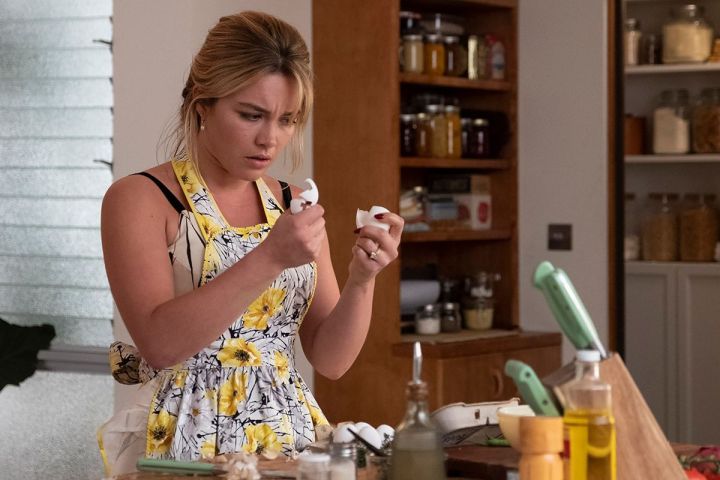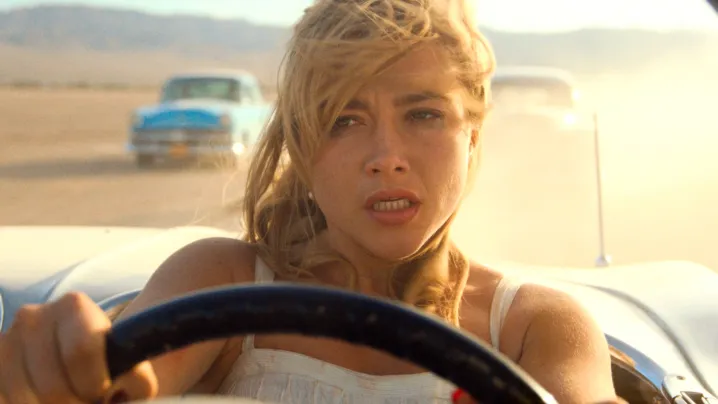The buzz surrounding Olivia Wilde’s Don’t Worry Darling has largely focused on the drama behind the scenes, but the film itself has enough twists and turns to spark discussion. For fans who want to know what happens in the film, and the shocking climax, this article is for you. For others who prefer to see it for themselves, visit your multiplex and then come back to read about what exactly happened in the mind-bending thriller and what those plot twists mean.
It is obvious right from the beginning that the idyllic 50’s-style community where Alice (Florence Pugh) and Jack Chambers (Harry Styles) live is not the utopia it seems to be. The town’s leader, Frank (Chris Pine) runs a vague company called the “Victory Project,” which all the husbands commute to every day, while the women stay home cooking dinner and doing all the household chores. But Alice starts to notice cracks in the town’s façade, spurring her to speak out against Frank and his followers. When she begs Jack to leave the town with her, he conspires to have her taken away by Frank’s henchmen.

The plot starts unraveling as Alice is given electric shock treatment in a hospital room. Suddenly we are transported into the present, where Alice is a stressed-out nurse at the end of a 30-hour shift. She returns home to her cramped apartment where Jack is sitting at the computer, looking disheveled and a far cry from his stylish 50’s look. He wants her to pay attention to him; she is too tired to give her unemployed nerdy boyfriend the time of the day, and she leaves him quietly fuming at his desk.
Jack is revealed to be listening to town leader Frank’s podcast, which offers the promise of a better world. Next, back in the 50’s world, Alice comes out of her electroshock refreshed and recalibrated, apparently forgetting everything she was worried about before. Very quickly, however, she snaps out of her submissive state, triggered by Jack humming the song that reminds her of her past life. She immediately realizes there is something really off about where she is.
Confronting Jack, she gets him to admit that they are not living in reality. After hearing about the Victory Project from the podcast, Frank had her involuntarily dragged into a virtual reality simulation of a male-fantasy utopia with her. Upset that she never had time for him, Jack lamely claims that he was trying to help her, to which she replies that only she should be in control of her own life. This is interspersed with present-day scenes of Jack tending to an unconscious Alice, hooked up on virtual-reality technology. It is revealed that Jack’s job is really just him exiting the simulation so he can make money in the real world before returning to the simulation.

The two immediately come to blows. As Jack tries to strangle her, she gets the best of him, breaking a glass over his head and killing him. Alice’s friend Bunny (Wilde) comes in from next door. She reveals that she has known the whole time that she is in a simulation, but that she consented because she wanted to raise children (even if they are just simulated children) after her own kids died.
She tells Alice that a death in Victory Project world is a death in real life, and that she better get out of there as fast as she can to spare her own life. Alice leaves the house, covered in Jack’s blood, as the whole street stops and stares at her. With her neighbors all protesting, she jumps into Jack’s car and speeds away, leading to a high-speed chase as the whole town tries to stop her from escaping.

As Frank hears the news that Alice is on the loose, his wife Shelley (Gemma Chan) stabs him to death, pronouncing “It’s my turn now,” and also calling him a stupid man. It is unclear if Shelley was in on the scheme the whole time, or if she is only now realizing that she is trapped in her husband’s virtual world. Alice is able to successfully evade the chasers and get back to the mysterious headquarters building she found earlier in the film.
Just as before, she steps up to the paneled glass window, presses her hands against it, and closes her eyes. Just before she does, she has a vision of Jack from the past, holding her and telling her they will always be together. The screen cuts to black and the film ends. Wilde leaves up to interpretation whether or not Alice is able to escape the simulation and save her own life in turn.


